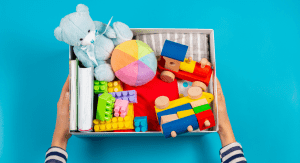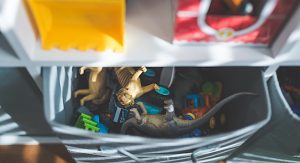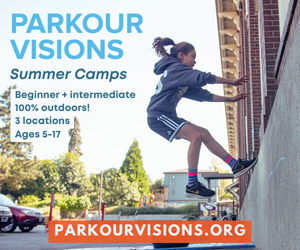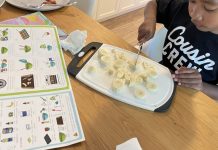Picture this: my daughter’s room is so crammed with stuff that I have to unearth her every morning, determining which lump is child and which a pile of clean clothing masquerading as another small human. Maybe not an original problem, but an embarrassing one for a woman who makes her living helping people rid their homes of clutter!
We do not come into the world understanding how to manage our possessions. In fact, for the majority of the population, it’s only in the modern age that we’ve had many possessions to manage. For eons, humans owned clothing and a few tools – no van required to move from one cave to another.
Now, of course, all that has changed, and we joyfully cram our homes with all kinds of detritus, most of it promising to be useful, entertaining, or both. And our kids burrow deeper and deeper into these piles of stuff, with no earthly idea of what to do with it all.
We have to teach our children how to manage their things.

What Comes In Must Go Out
Mountains of money goes into helping us acquire; marketing budgets and data collection power the machine that keeps us buying. But no one seems to be educating us about how to divest ourselves of the things that no longer serve us.
Not to worry – there’s still hope.
I’m not suggesting you raise minimalist children or deny them their 75th box of Legos. But there are some simple strategies you can teach your children (and practice yourself!) to keep the flow of possessions from burying them completely.
Six Approaches to Helping Kids Declutter
1. Start with trash and recycling. Kids will hold on to packaging; a lot of the junk that fills their rooms is made up of instruction booklets, plastic bags, cardboard boxes and all the wreckage of toy unwrapping. Get them used to recycling or throwing away all that extra stuff.
2. Do you have a chore chart? Add decluttering to it. “Find 5 things you no longer need.” When my kids were small, they’d each get a list of tasks to accomplish by the end of the weekend. It always included a random number of items to discard.
3. Hand your kid an empty grocery sack and ask her to fill it with stuff she no longer wants. This one is especially good for older kids. (They’re at the right age when the very suggestion of discarding unloved items causes sighs and eyerolls.) It’s amazing how quickly that bag will appear, full to the brim, outside her bedroom door, as long as you’re not breathing down her neck.
4. Help your child to find homes for all of his stuff, and to return items to those homes on a regular basis. If the box that holds miniature animals is full, it’s time to let go of a few. Or find a bigger box, of course, but fitting your possessions into the available storage space is a lesson we all need to learn.
5. Talk about the concept of ownership. We’re emotionally attached to our things, and that makes it hard to let go, even when we’ve finished using them. But possessions move in and out of our lives. You wouldn’t want to keep every toothbrush you’ve ever owned, would you? You can begin teaching your kids that the memories they associate with their old toys and clothing are still theirs to keep, even when the physical items are gone.
6. Model the behavior you’d like to see. Ouch. Easier said than done, I know. But if your kids see you committing to decluttering, you’ll normalize the behavior. Maybe everyone in the house finds ten things to discard over the course of the week, or you enlist their help in going through the garage and hauling away the unused junk.

Start Early, Don’t Give Up
My best advice? Get your kids onboard when they’re little; you’ll save yourself hours of nagging down the road.
My daughter, she of the junk-filled room, lives in her own apartment now. Is her room less crowded? I think so, though I’m now blissfully unaware of the state of her home. She still owns a LOT of stuff; she’s a maximalist. But she’s gotten a lot better at curating her possessions and even seems to enjoy it.
I know that we can only teach them and hope for the best, but it’s awfully gratifying to see our kids actually live out the lessons we’ve tried to bang into their little heads. Learning to manage their stuff may not be mission critical, but it will help them lead saner, happier lives.



















So true Julia—ALL of it!
Starting early IS the key. Too bad we don’t always figure that out until wayyyy later.
Great tips/approaches for kid decluttering—really helpful! Now, If only we could go backwards in time! 🙂
Comments are closed.